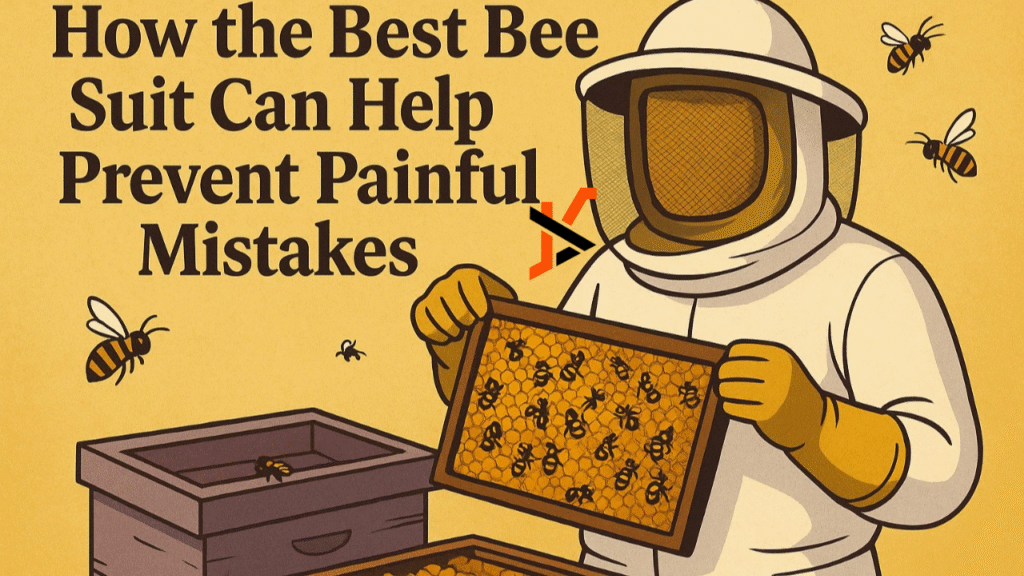Working with bees is exciting, rewarding, and—let’s be honest—a little nerve-wracking at times. Bees are gentle creatures when handled with care, but one wrong move or poor protection can lead to painful stings and stressful situations.
That’s where the best bee suits come in. A well-made suit not only protects you from stings but also helps you work with your bees calmly and with confidence. In this guide, we’ll explain how choosing the right bee suit can help you avoid common mistakes, protect your health, and make beekeeping more enjoyable.
Why Choosing the Best Bee Suit Matters
Your bee suit is more than just clothing—it’s your personal shield. The best bee suits protect you from:
- Painful stings that can cause swelling and allergic reactions
- Accidental bee entries through gaps or loose areas
- Heat stress during summer beekeeping sessions with ventilated designs
- Tearing or fabric wear that can happen with cheap materials
When you feel safe, you work more calmly. Calm movements mean you’re less likely to agitate the bees, which reduces your chances of getting stung in the first place.
Common Beekeeping Mistakes Caused by Poor Gear
Many painful beekeeping mistakes aren’t caused by inexperience—they’re caused by low-quality gear. Here are some examples:
- Wearing suits that are too thin – Bees can sting right through cheap, thin fabric.
- Loose-fitting zippers or cuffs – These leave gaps where bees can sneak in.
- Overheating in non-ventilated suits – Heat exhaustion can make you rush and make mistakes.
- Ignoring proper coverage – Skipping gloves or using a half-suit leaves areas exposed.
These mistakes can easily be avoided by investing in best bee suits with proper stitching, closures, and materials.
Key Features That Define the Best Bee Suits
When shopping for a bee suit, don’t just pick the cheapest option—look for these features that separate the best from the rest:
1. Sting-Proof Fabric
The material should be thick enough to prevent stings, yet breathable for comfort. Many professional bee suits use triple-layer mesh for protection and airflow.
2. Full-Body Coverage
A full-body beekeeping suit with elastic wrists, ankles, and a secure veil gives maximum protection.
3. Ventilation for Comfort
Ventilated bee suits keep you cool during summer hive inspections, so you can work longer without overheating.
4. Durable Zippers and Closures
Durable zippers paired with overlapping flaps keep bees from finding their way inside through any gaps.
5. Freedom of Movement
Lightweight bee suits allow you to bend, lift, and move without feeling restricted.
How the Best Bee Suits Protect You from Stings
A quality bee suit serves as a protective shield between you and your bees. Here’s how it works:
- Elastic cuffs and ankles seal off entry points, preventing bees from crawling in.
- Secure Veil Attachment – Keeps your face and neck safe from stings.
- Triple-Layer Fabric – Gives space between you and the bees’ stingers.
- Reinforced Seams – Prevents tearing even with frequent use.
When you have full protection, you’re less likely to panic if bees fly near your face, which makes the bees calmer too.
Matching the Right Suit to Your Beekeeping Style
Not all beekeepers need the same type of suit. Here’s how to choose:
- Beginner Bee Suits – Choose full-body beekeeping suits with strong zippers and full coverage for extra protection.
- Professional Bee Suits – Invest in best bee suits for long inspection days.
- Budget-Friendly Bee Suits – Opt for affordable bee suits with good stitching rather than the cheapest possible.
- Lightweight Bee Suits – Great for quick hive checks in warm climates.
Tip: If you work in hot areas, ventilation is key. If you have aggressive bees, choose thicker, sting-proof designs.
Steps to Use a Bee Suit Safely
Even the best bee suits won’t work if you don’t wear them properly. Follow these steps:
- Inspect Your Suit Before Use
- Check for holes, loose seams, or broken zippers.
- Make sure the veil is securely attached.
- Put On the Suit Correctly
- Step in carefully, avoiding snags.
- Zip up completely and overlap any flaps.
- Secure All Openings
- Pull elastic cuffs over gloves.
- Tighten ankle cuffs over boots.
- Test Before Entering the Apiary
- Move around to ensure the suit doesn’t ride up.
- Ask a fellow beekeeper to check for exposed areas.
- Stay Calm Around Bees
- Move slowly and avoid sudden motions.
- Your calm demeanor helps keep the bees calm as well.
Tips for Maintaining Your Bee Suit for Long-Term Use
To keep your sting-proof bee suit in top shape:
- Wash regularly to remove bee scent and propolis.
- Avoid harsh chemicals that can weaken fabric.
- Hang to dry instead of using high heat.
- Check seams and zippers after every few uses.
- Store in a dry place to avoid mold or fabric damage.
A well-maintained bee suit can last for years, saving you money in the long run.
Conclusion: Invest in the Best to Avoid Painful Mistakes
Beekeeping should be a rewarding and enjoyable experience—not one filled with stings and stress. By choosing the best bee suits, you protect yourself from common mistakes caused by poor gear, work more confidently around your bees, and improve your overall beekeeping skills.Whether you’re a beginner or a seasoned beekeeper, investing in quality beekeeping safety gear is one of the smartest decisions you can make.

